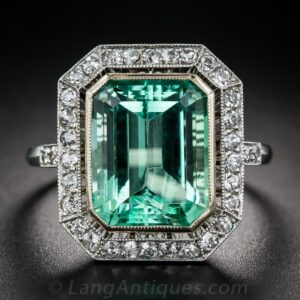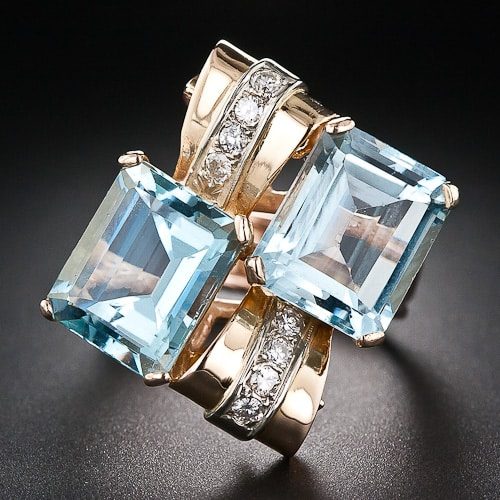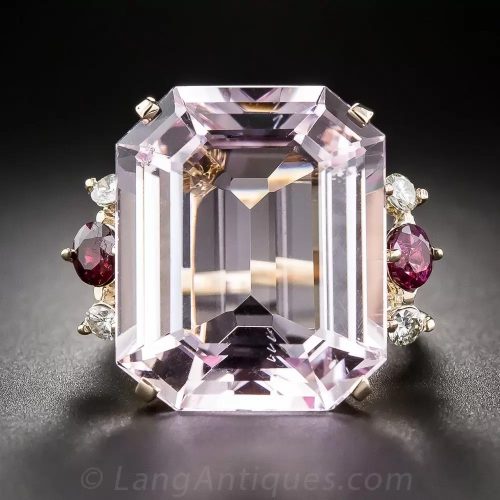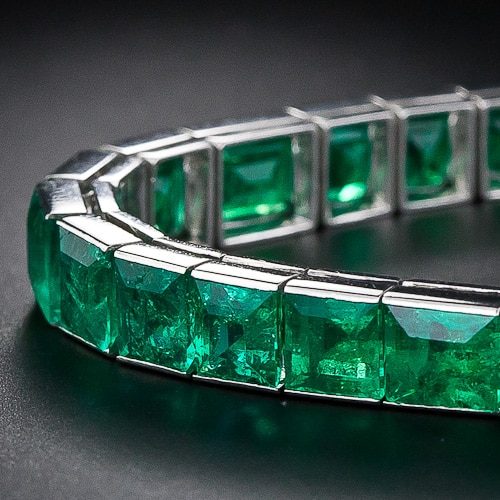
Beryl is a beryllium aluminum silicate that occurs in every color of the rainbow but is colorless in pure form; various metallic impurities give beryl its varied coloration.
When green, it’s an emerald. When blue, it’s termed aquamarine. When pink, morganite. There is a berry red variety called Bixbite, found in Utah. Heliodor is the yellow variety of beryl and goshenite is colorless. There is a very rare and costly variety termed Riesling beryl, which can be described as pale green color, with a warm golden-yellow flash.
With the exception of emerald, beryl is considered to be a tough and durable gem. Beryl is most often found in beds of granitic pegmatites. The pure, colorless beryls are found within gas cavities in the pegmatites, where metallic oxides are unable to permeate the crystals.
Certain beryls can attain a weak cat’s-eye or star effect. The Los Angeles County Museum of Natural History displays a cats-eye beryl weighing 211 carats and a star beryl weighing more than 11 carats.
A Brief History of Beryl
Beryl was widely known in antiquity. The name beryl originates from the Ancient Greek “beryllos” which was once applied to all green gemstones but later used only for beryl. It has always been a stone of mystics. It’s transparency was a perfect medium for crystal gazing making a seer’s vision of prophecy and future events very efficient. Greek physicians made a gemstone elixir to cure bladder infections and kidney stones, by dosing patients with water into which beryl had been dipped. In the 14th Century A.D., Konrad von Megenberg chose the same remedy for asthma. Medieval physicians claimed beryl to be a sure cure for liver disease and jaundice.
A beryl carved into the image of a frog was thought to turn enemies into friends. And when engraved with the bird, hoopoe, it could invoke the spirits of the dead.
Beryl is associated with Scorpio or Gemini.



Gemological Information for Beryl
| Color: | Red, pink, yellow, green, blue and colorless. |
| Crystal Structure: | Hexagonal |
| Refractive Index: | 1.577-1.583 |
| Durability: | Excellent (Emerald is Brittle) |
| Hardness: | 7.5-8 |
| Family: | Beryl |
| Similar Stones: | Beryl can be Confused by Appearance by a Number of Stones, as Quartz, Glass and Zircon |
| Treatments: | Heat Treatment, Oiling, Waxing |
| Country of Origin: | Beryl is found worldwide, most notably in Argentina, Afghanistan, Africa, India, United States and Brazil |
Beryl Care
| Ultrasonic Cleaning: | Not Safe |
| Steam Cleaning: | Not Safe |
| Warm Soapy Water: | Safe with a soft brush (emerald may be risky) |
| Chemical Attack: | Usually none (emerald may be risky) |
| Light Sensitivity: | May Fade |
| Heat Sensitivity: | May Fade |
Gems & Gemology: The Quarterly Journal of The Gemological Institute of America.
Beryl:
- July-Aug. 1935, Maxixe Beryl, p. 294, 1p.
- Summer 1949, 40 lbs. of Beryl Found in Pocket, Brazil, p. 194, 1p.
- Fall 1950, A 2,000 ct. Aquamarine from Brazil, p. 351, 1p.
- Summer 1954, Inclusions in a Madagascan Yellow Beryl, by Webster, p. 60, 3pp.
- Fall 1955, A Golden Beryl Cat’s-Eye, p. 197, 2pp.
- Fall 1955, Aquamarine Cat’s-Eye, p. 198, 2pp.
- Fall 1955, Star Beryl, p. 199, 1p.
- Winter 1964, A 15.4 lb. and a 74.65 lb. Brazilian Aquamarine, p. 239, 3pp.
- Summer 1968, Irradiated Morganite, p. 315, 2pp.
- Spring 1970, Interesting Beryl Inclusion, p. 148, 2pp.
- Fall 1971, Star Beryl, p. 356, 1p.
- Spring 1972, Unusual Inclusions in Aquamarine, p. 24, 2pp.
- Winter 1972, Dark-Blue Aquamarine-Origin Unsure, p. 111, 2pp.
- Spring 1973, Maxixe-Type Blue and Green Beryl, by Nassau, p. 130, 4pp.
- Spring 1973, Maxixe-Type Blue and Green Beryl, Simple Test, p. 139, 2pp.
- Summer 1973, Maxixe-Type Beryl not Bombarded, p. 172, 2pp.
- Summer 1977, Tarnish Seen on Faceted Beryls, p. 310, 1p.
- Winter 1980, An Examination of Red Beryl, by Frank Miley, p. 405, 4pp.